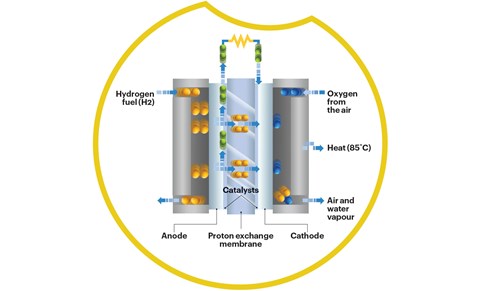► Hydrogen power is here – but will it stay?
► Lack of infrastructure stymies growth
► Government grants to develop stations
Hydrogen-fuelled cars have been years away from mass production for years. But could these zero-emissions electric vehicles – fuelled by earth’s most abundant element, emitting nothing but water from their exhausts – finally be on the cusp of a long-overdue breakthrough? With the hydrogen fuel-cell Toyota Mirai now available in the UK, alongside the older Hyundai ix35 Fuel Cell – and the government pledging £6.6 million for refuelling stations – the latest developments are positive.
Toyota chief engineer Yoshikazu Tanaka is cautiously optimistic. ‘We’ve been studying fuel cells since 1992, and there are many advantages: it takes a similar time to petrol to refuel, hydrogen has seven times the power of a lithium-ion battery in battery-electric vehicles, with zero emissions and a long driving range.’
But limited refuelling stations makes leasing a fuel-cell a leap of faith – the Mirai family saloon is priced around £66,000, the ix35 crossover (when new) £53,105 – with low volumes and sky-high development costs to blame. ‘The Mirai has 370 individual fuel-cells with a thickness of 1.34mm arranged in a fuel-cell stack,’ explains Tanaka-san. ‘The stack is compact, high power and highly efficient, but its complexity presents a challenge to make the thousands of units required for the Mirai, let alone truly mass-produced volumes.’
Streamlining production and adding bodystyles like SUVs will boost the economies of scale, and Toyota and BMW are collaborating to generate further synergies. BMW powertrain engineer Matthias Klietz – the man behind a 5-series GT fuel-cell concept – explains the logic: ‘Our objective is to accelerate development, share expertise and cut costs; fuel-cells will eventually be cheaper than battery-electric cars.’
Toyota foresees a mixed portfolio: BEVs to provide ‘personal mobility’ in cities, with hydrogen fuel-cells best suited to larger cars and longer trips; the Mirai has a range of over 400 miles, far greater than the 100-or-so miles typical of most BEVs. Hybrids and plug-ins cover the middleground with fossil-fuel comfort blankets.
Refuelling infrastructure remains the biggest hurdle. Hydrogen corridors are being developed and planned across Europe, the US and Asia: Germany’s 50 existing refuelling stations should balloon to 400 by 2023; Japan’s network is planned to grow from today’s 100 stations to 800 in 2025.
But even early-adopting California – along with Japan, the only other market to offer Honda’s FCX fuel-cell trial in 2007 – has only 10 stations. The UK government’s cash pledge will create just seven new stations, for a total of 12 nationwide; there are more than 8000 petrol stations.
‘Even though the tech is there, you need co-operation between governments, car companies and fuel companies, ‘ says Tanaka. ‘In future, car companies may play a larger role; it’s moving that way in Japan.’
Toyota plans to increase production of the Mirai from 700 units in 2015 to 3000 by 2017, and Tanaka tentatively hopes to see a ten-fold increase to 7000 units by 2020. By then, partner BMW is aiming to have ‘production-ready components’. The ball might be rolling slowly, but it’s gathering momentum nonetheless.

How it works
1) Hydrogen is pumped into the Mirai at a service station, in much the same way – and taking a similar length of time – as filling a petrol car
2) Hydrogen is stored in fuel tanks at 700 bar. Made of light carbonfibre, an inner layer of polyamide resin resists hydrogen permeation. Gas is sent forward to the fuel-cell stack
3) Large air intakes at the front of the Mirai channel oxygen into the fuel-cell stack. When the hydrogen and oxygen meet, a catalyst prompts a chemical reaction that produces electricity, heat and water. The electricity is used to drive the car’s 154bhp electric motor, while the harmless water vapour is emitted from the Mirai’s exhaust pipe
4) A rear battery provides extra assistance to the electric motor under harder acceleration. At very low speeds the battery can also provide the sole source of power to the electric motor, eliminating hydrogen use. When the driver brakes or coasts, the Mirai captures the wasted energy to recharge the battery
Read more CAR tech features and news here